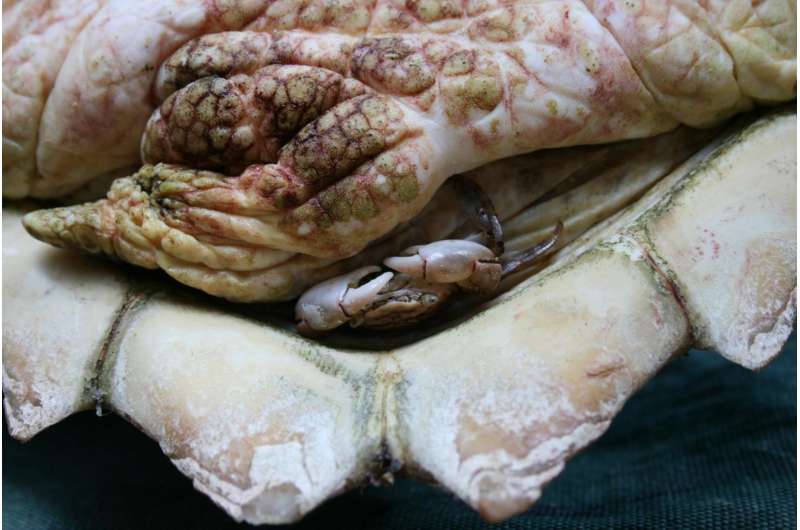September 22, 2016 report
Oceanic crab found to change its mating habits based on refuge size

(Phys.org)—A pair of researchers has found that a type of oceanic crab (Planes minutus) alters its mating habits based on the relative size of its refuge. In their paper published in the journal Biology Letters, Joseph Pfaller with the University of Florida and Michael Gil with the University of California describe their study of the crabs and their mating habits in light of resource constraints.
P. minutus is a type of tiny (half-inch long) pelagic crab that lives in the open ocean—it is notable because it makes its home on things that float, such as logs, weeds and even the hulls of ships. In this new effort, the researches focused on those crabs that lived either on floating plastic debris 'islands' or in the small space below the tail of loggerhead turtles and its shell—a space just large enough for two of the crabs to live—one male and one female.
The researchers sought to test a biology theory that suggests that larger groups of refuge-dwelling animals should be more inclusive than those that are smaller and thus more exclusive. To that end, they conducted a survey of the oceanic crabs by sailing out onto the North Pacific Subtropical Gyre (a vortex where plastic trash tends to congregate) and corralling floating items and then snatching the crabs that were living on them—each specimen was preserved in ethanol and then catalogued.
As part of the analysis, they noted that the size of a given turtle did not matter, other than it was big enough to serve as a host—only two crabs ever paired up and used the turtle's back-end as a home. This suggested that it was not the size of the turtle that mattered but the size of the refuge it offered. In this case, the crabs all lived a monogamous lifestyle. They found the same thing when looking at crabs living on small patches of barnacles. In sharp contrast, they noted that crabs that lived on larger refuge sites such as floating plastic, gave up the monogamous lifestyle, opting instead to play the field. This, the team suggests, was likely mostly due to the inability to defend an open space against interlopers.
These differences, the researchers note, indicates an adaptation by the crabs—one that fit neatly with the theory they were seeking to bolster—that the crabs did become more exclusive as their group became smaller.
More information: Joseph B. Pfaller et al. Sea turtle symbiosis facilitates social monogamy in oceanic crabs via refuge size, Biology Letters (2016). DOI: 10.1098/rsbl.2016.0607
Abstract
The capacity for resource monopolization by individuals often dictates the size and composition of animal groups, and ultimately, the adoption of mating strategies. For refuge-dwelling animals, the ability (or inability) of individuals to monopolize refuges should depend on the relative size of the refuge. In theory, groups should be larger and more inclusive when refuges are large, and smaller and more exclusive when refuges are small, regardless of refuge type. We test this prediction by comparing the size and composition of groups of oceanic crabs (Planes minutus) living on plastic flotsam and loggerhead sea turtles. We found that (i) surface area of refuges (barnacle colonies on flotsam and supracaudal space on turtles) is a better predictor of crab number than total surface area and (ii) flotsam and turtles with similar refuge surface area host a similar number (1–2) and composition (adult male–female pairs) of crabs. These results indicate that group size and composition of refuge-dwelling animals are modulated by refuge size and the capacity for refuge monopolization. Moreover, these results suggest that sea turtle symbiosis facilitates social monogamy in oceanic crabs, providing insights into how symbiosis can promote specific mating strategies.
Journal information: BMC Ecology , Biology Letters
© 2016 Phys.org





















